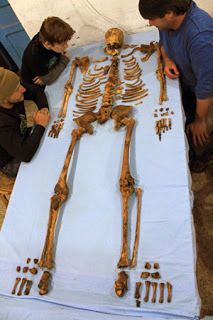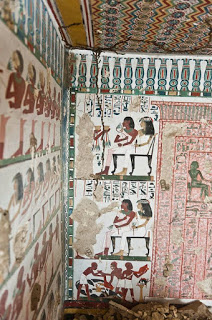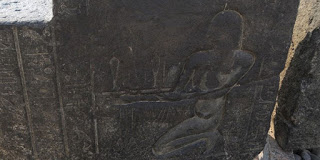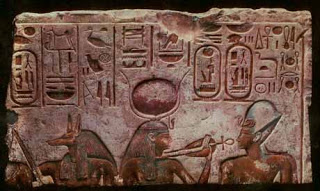Egypt

As the year 2015 comes to a close it is time to take a brief look back at the events of the past year in the world of Egyptology. It has been a busy year for researchers of her ancient culture as the past reveals itself in a myriad of excavations from Aswan to Alexandria. The year has also produced large amounts of stolen artifacts from illegal excavations over the years that have been smuggled abroad, and now are being repatriated back to Egypt.
Dr. Otto Schaden past away this year. Most people will know him best as the discoverer of Valley of the Kings tomb Kv 63, but Dr Schaden's work in the Valley of the Kings also included clearing the tomb of King Ay, WV 23, and the tomb of Amemesses, KV 10.
In January an Egyptian fortress was discovered in the Sinai at Tell Habua near the Suez canal. The fort corresponds as belonging to the Way of Horus recorded in inscriptions on the walls at Karnak. A unique carved relief was discovered at Aswan this year depicting an unknown king making offerings to the god's Toth and Amun-Re. It is believed to be the first time the two god's have been depicted together.
It was unbelievably announced that Tutankhamun's mask had been damaged some months earlier and had its beard broken off. To make matters worse it was poorly glued back on, and now will be heading back into repair to remove the glue, and put the beard on properly. Soon archaeologists were met with the discovery of the tomb at Saqqara of an unknown queen named Khent-Kawes (III). The tomb was found by the Czech mission headed by Miroslav Barta. It appears this queen might be the wife of the Fifth Dynasty King Neferirkare.

Also came the announcement from Abydos of the finding of a tomb of a little known Thirteenth Dynasty king named Woseribre Senebkay. The small tombs walls are pleasantly decorated with the burial of the king thoroughly destroyed leaving only fragments with what is thought to be Senebkay's skeleton. Analysis of the king's remains suggests he had suffered a brutal death.
In March came the discovery of a beautifully painted tomb of a New Kingdom noble named Sa-Mut and his wife Ta Khaeet opposite Luxor in a cemetery known as the Valley of the Nobles. The tomb being found by a joint American/Egyptian mission of the American Research Center in Egypt. The tomb dates to the 18th Dynasty and has damage dating to the Amarna period.

A cache of artifacts was also found at Karnak temple including statues of the baboon god Djehuty as well as statuettes of Osiris, Mut, and Bastet. The discovery was made at the temple of Ptah, originally built by Thutmosis III, (1479 B.C.-1424 B.C.). Included among the string of repatriated antiquities that came home to Egypt throughout the year, is a relief belonging to a temple of Thutmosis IV, also at Karnak.
Some scandal was aroused in the spring regarding the authenticity of the famous fresco of geese in the Cairo Museum. The geese are from the Third Dynasty mastaba of Nefermaat, a unique Old Kingdom tomb at Meidum. The theory certainly achieved the goal of getting press attention even if it received no merit.

This sites guide reviews have developed a nice audience with some of this years most popular reviews being, The Illustrated Guide to the Egyptian Museum in Cairo, and a rare copy of, The Luxor Museum of Ancient Egyptian Art. Articles from this site have also done well include, The Talatat Wall in the Luxor Museum, and the first edition of Tuesday's Egyptian shows promise.
Polish archaeologists have found a unique six thousand five hundred year old burial in the western desert at a place called Gebel Ramlah. In one grave containing two individuals, one of them had cuts on his femur, and in another the deceased was showered with shards of pottery and stone. This years most bizarre Egyptology note is the finding of a 2000 year old mummy at a French garbage dump. I do not get it, the woman knows she's throwing out a mummy, did she never hear of a museum?

A terrorist attack at Luxor this year did not harm the temple, or any bystanders, but is a reminder of the dangers faced by innocent Egyptians and visitors. Six tombs from Dynasty XXVI were found at Aswan beside the Aga Khan Mausoleum on Aswan's west bank. The tombs contain many artifacts though they were robbed in 2011 during the revolution.
It could be suggested that the biggest news in Egyptology this year came in late summer with well respected Egyptologist Nicholas Reeves announcement that he believed King Tutankhamun's tomb contains more chambers, and that Mr Reeves believes Nefertiti's burial is in one of them, and perhaps some of her daughters too. If Nefertiti is present I would suggest her daughter Meketaten will be with her.
The big runners for Egyptians this year include these two from the summer of 2014, "The Great Pharaoh Ramses and his time: Expo 86", and "Was King Hatshepsut the Original Owner of Theban Tomb 358?" At Giza the great pyramid has been under going a series of scans to see if there are anomalies such as hidden chambers. The scans taken at sunset and sunrise use infrared thermography to see the cooling and heating up of the pyramids blocks.

The ruins of a shrine built by the first king of the Thirtieth Dynasty, Nectanebo I, have been found under modern Cairo. The shrine is a small reminder of what was once the great city of Heliopolis that today with the exception of a Middle Kingdom obelisk of Senusert I, is completely lost to the city of Cairo
Among the prettiest artifacts returning back to Egypt is this sunk relief of the great King Seti I. The relief turned up at auction in London recently and was authenticated as genuine and stolen. Who would think that they could actually sell something as outstanding as this without firm proof of its provenance.

Well it has been one of those years where technology both new and ancient come together to leave us with more questions than answers. This is of course only a short rundown of what was a rather full year in Egyptology.
Images:
Photo of tomb of Sa-Mut-Courtesy of the Egyptian Antiquities Ministry
Skeleton of Woseribre Senebkay- (Photo: Jennifer Wegner, Penn Museum)
The Rueil-Malmaison Mummy Photograph: Joel Saget/AFP/Getty Images
Shrine of Nectanebo I- Courtesy of the Egyptian Antiquities Ministry
Seti I, relief-Ahram Online
- The Truth In The Search For Nefertiti
In a very flawed article from the Archaeology News Network, the former head of Egypt's Supreme Council of Antiquities, Dr. Zahi Hawass disputes Egyptologist Nicholas Reeves theory that the tomb of Nefertiti will be found behind the painted walls...
- The Tomb Of Nefertiti
Well all is set for Egyptologist Nicholas Reeves to investigate Tutankhamun's tomb hoping to find a doorway behind one of two walls or both. Mr. Reeves believes that Nefertiti's burial chamber may be behind one of them. This theory coming from...
- A Year Of Destiny And History
I started this year with The Egyptian Book of the Dead on my mind finding in it a document of incredible abstraction and a sense accomplishment. In the middle of January reports that KV64 had been found in the Valley of Kings was met with...
- A Broken Statue Of Tutankhamun
During the recent Egyptian revolution a pack of robbers entered the Cairo museum stealing and smashing a number of the museums artifacts. The images of the following day included a broken gilded statuette of a feminine king walking on a plinth on the...
- The Great Missing
There is little doubt of three caches of kings from the end of the New Kingdom yet one cache is clearly missing and perhaps today represented only by its absence. The great cache of 1881 found a prince named Ahmosis though sadly he is not the liberator...
Egypt
Egyptology in 2015
As the year 2015 comes to a close it is time to take a brief look back at the events of the past year in the world of Egyptology. It has been a busy year for researchers of her ancient culture as the past reveals itself in a myriad of excavations from Aswan to Alexandria. The year has also produced large amounts of stolen artifacts from illegal excavations over the years that have been smuggled abroad, and now are being repatriated back to Egypt.
Dr. Otto Schaden past away this year. Most people will know him best as the discoverer of Valley of the Kings tomb Kv 63, but Dr Schaden's work in the Valley of the Kings also included clearing the tomb of King Ay, WV 23, and the tomb of Amemesses, KV 10.
In January an Egyptian fortress was discovered in the Sinai at Tell Habua near the Suez canal. The fort corresponds as belonging to the Way of Horus recorded in inscriptions on the walls at Karnak. A unique carved relief was discovered at Aswan this year depicting an unknown king making offerings to the god's Toth and Amun-Re. It is believed to be the first time the two god's have been depicted together.
It was unbelievably announced that Tutankhamun's mask had been damaged some months earlier and had its beard broken off. To make matters worse it was poorly glued back on, and now will be heading back into repair to remove the glue, and put the beard on properly. Soon archaeologists were met with the discovery of the tomb at Saqqara of an unknown queen named Khent-Kawes (III). The tomb was found by the Czech mission headed by Miroslav Barta. It appears this queen might be the wife of the Fifth Dynasty King Neferirkare.

Also came the announcement from Abydos of the finding of a tomb of a little known Thirteenth Dynasty king named Woseribre Senebkay. The small tombs walls are pleasantly decorated with the burial of the king thoroughly destroyed leaving only fragments with what is thought to be Senebkay's skeleton. Analysis of the king's remains suggests he had suffered a brutal death.
In March came the discovery of a beautifully painted tomb of a New Kingdom noble named Sa-Mut and his wife Ta Khaeet opposite Luxor in a cemetery known as the Valley of the Nobles. The tomb being found by a joint American/Egyptian mission of the American Research Center in Egypt. The tomb dates to the 18th Dynasty and has damage dating to the Amarna period.

A cache of artifacts was also found at Karnak temple including statues of the baboon god Djehuty as well as statuettes of Osiris, Mut, and Bastet. The discovery was made at the temple of Ptah, originally built by Thutmosis III, (1479 B.C.-1424 B.C.). Included among the string of repatriated antiquities that came home to Egypt throughout the year, is a relief belonging to a temple of Thutmosis IV, also at Karnak.
Some scandal was aroused in the spring regarding the authenticity of the famous fresco of geese in the Cairo Museum. The geese are from the Third Dynasty mastaba of Nefermaat, a unique Old Kingdom tomb at Meidum. The theory certainly achieved the goal of getting press attention even if it received no merit.
This sites guide reviews have developed a nice audience with some of this years most popular reviews being, The Illustrated Guide to the Egyptian Museum in Cairo, and a rare copy of, The Luxor Museum of Ancient Egyptian Art. Articles from this site have also done well include, The Talatat Wall in the Luxor Museum, and the first edition of Tuesday's Egyptian shows promise.
Polish archaeologists have found a unique six thousand five hundred year old burial in the western desert at a place called Gebel Ramlah. In one grave containing two individuals, one of them had cuts on his femur, and in another the deceased was showered with shards of pottery and stone. This years most bizarre Egyptology note is the finding of a 2000 year old mummy at a French garbage dump. I do not get it, the woman knows she's throwing out a mummy, did she never hear of a museum?

A terrorist attack at Luxor this year did not harm the temple, or any bystanders, but is a reminder of the dangers faced by innocent Egyptians and visitors. Six tombs from Dynasty XXVI were found at Aswan beside the Aga Khan Mausoleum on Aswan's west bank. The tombs contain many artifacts though they were robbed in 2011 during the revolution.
It could be suggested that the biggest news in Egyptology this year came in late summer with well respected Egyptologist Nicholas Reeves announcement that he believed King Tutankhamun's tomb contains more chambers, and that Mr Reeves believes Nefertiti's burial is in one of them, and perhaps some of her daughters too. If Nefertiti is present I would suggest her daughter Meketaten will be with her.
The big runners for Egyptians this year include these two from the summer of 2014, "The Great Pharaoh Ramses and his time: Expo 86", and "Was King Hatshepsut the Original Owner of Theban Tomb 358?" At Giza the great pyramid has been under going a series of scans to see if there are anomalies such as hidden chambers. The scans taken at sunset and sunrise use infrared thermography to see the cooling and heating up of the pyramids blocks.

The ruins of a shrine built by the first king of the Thirtieth Dynasty, Nectanebo I, have been found under modern Cairo. The shrine is a small reminder of what was once the great city of Heliopolis that today with the exception of a Middle Kingdom obelisk of Senusert I, is completely lost to the city of Cairo
Among the prettiest artifacts returning back to Egypt is this sunk relief of the great King Seti I. The relief turned up at auction in London recently and was authenticated as genuine and stolen. Who would think that they could actually sell something as outstanding as this without firm proof of its provenance.

Well it has been one of those years where technology both new and ancient come together to leave us with more questions than answers. This is of course only a short rundown of what was a rather full year in Egyptology.
Images:
Photo of tomb of Sa-Mut-Courtesy of the Egyptian Antiquities Ministry
Skeleton of Woseribre Senebkay- (Photo: Jennifer Wegner, Penn Museum)
The Rueil-Malmaison Mummy Photograph: Joel Saget/AFP/Getty Images
Shrine of Nectanebo I- Courtesy of the Egyptian Antiquities Ministry
Seti I, relief-Ahram Online
- The Truth In The Search For Nefertiti
In a very flawed article from the Archaeology News Network, the former head of Egypt's Supreme Council of Antiquities, Dr. Zahi Hawass disputes Egyptologist Nicholas Reeves theory that the tomb of Nefertiti will be found behind the painted walls...
- The Tomb Of Nefertiti
Well all is set for Egyptologist Nicholas Reeves to investigate Tutankhamun's tomb hoping to find a doorway behind one of two walls or both. Mr. Reeves believes that Nefertiti's burial chamber may be behind one of them. This theory coming from...
- A Year Of Destiny And History
I started this year with The Egyptian Book of the Dead on my mind finding in it a document of incredible abstraction and a sense accomplishment. In the middle of January reports that KV64 had been found in the Valley of Kings was met with...
- A Broken Statue Of Tutankhamun
During the recent Egyptian revolution a pack of robbers entered the Cairo museum stealing and smashing a number of the museums artifacts. The images of the following day included a broken gilded statuette of a feminine king walking on a plinth on the...
- The Great Missing
There is little doubt of three caches of kings from the end of the New Kingdom yet one cache is clearly missing and perhaps today represented only by its absence. The great cache of 1881 found a prince named Ahmosis though sadly he is not the liberator...
